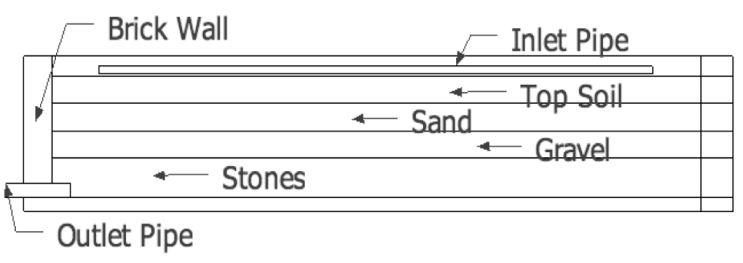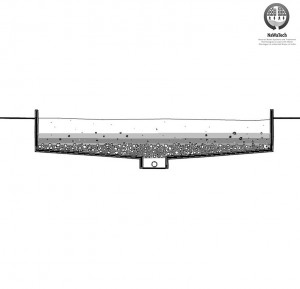Executive Summary
Non-planted sand or gravel filters are frequently applied for domestic greywater treatment throughout the world. It consists in a container filled with sand and/or gravel, through which wastewater flows and is filtered. There are several types of non-planted filters. The most successful is a vertical-flow filter in combination with a pre-treatment facility (e.g. septic tank).
| The contents of this factsheet are results of the Indo-European Project NaWaTech- “Natural Water Systems and Treatment Technologies to cope with Water Shortages in Urbanised Areas in India”, co-financed by the EC and the DST – India. |
Design and Construction Principles

Design of a Non-Planted Filter
In a non-planted filter, solids are removed by filtration and sedimentation, and organic matter degradation occurs by microorganisms that colonise the filter bed. Chemical adsorption of pollutants onto the media surface also plays a role in removal of some chemical constituents (e.g. phosphorus). The basic structure consists of a watertight box filled with granular material. The most usual depth of vertical filters is 1 to 1.20 m. However, if there is enough natural slope and good ventilation of the influent, vertical filters can also be built up to a depth of 3 metres (SASSE 1998). Hydraulic loading ranges between 40-60 L/m2.d, while space needed ranges from 5 to 10 m2/PE depending on the design and the goals of the treatment (CRITES & TCHOBANOGLOUS 1998). Although different materials, such as pea gravel, peat or crushed glass, can be applied as filter media in non-planted filters, sand is the most widespread material used. Before the pre-treated wastewater or greywater enters the filter body, a pre-treatment is very important to remove oil, grease and solid materials. Septic tanks or anaerobic reactors are a common solution for primary treatment. A properly operated non-planted filter can produce high-quality effluent with less than 10 mg/L BOD (90–95% removal) and less than 10 mg/L TSS (90–95%). Nitrogen removal is rather limited (30–40%) (MOREL & DIENER 2006). Bacteria, virus and phosphorus removal is enhanced when using sand rich in iron oxides (HEEB et al. 2007).
Operation and Maintenance
Regular maintenance works at the treatment facility comprises removal of unwanted vegetation from filter bed and cleaning of the inlet/outlet systems. The sludge from the pre-treatment system is removed regularly (depends on system) and managed correctly. The filter bed maintenance becomes more complicated when it is covered (UN-HABITAT 2008). As for constructed wetlands, the most important concern is clogging. With time, the gravel will become clogged with accumulated solids and bacterial film. The material may have to be replaced every 8 to 15 or more years. The pre-treatment facility must be maintained and emptied regularly.
Cost Considerations
Capital costs are moderate compared to intensive treatment options. They are mainly related to land requirements and purchase. Costs for materials are limited if they are locally available (SANIMAS 2005). Furthermore, use of feeder pumps increases operational costs (SANIMAS 2005) as well as maintenance and periodically emptying of the pre-treatment facility (e.g. septic tank). Considering capital and operation and maintenance costs, non-planted filters are still less expensive than intensive treatment options (i.e. activated sludge).
Experiences in Europe and other Cities of the World
Since the 1950s, sand and gravel filters have enjoyed a resurgence of interest and today they are among the most successful methods for onsite wastewater treatment over the world. Their capability for nutrient and pathogen removal, their low maintenance and power requirements, and their tolerance for periodic surges in loading rates make them practical and economic. Non-planted filters are very common in the United States of America. CRITES & TCHOBANOGLOUS (1998) reported several successful experiences of non-planted filters implementation to treat wastewater in small communities since 1940s. Sand was the mostly used medium while septic tanks or settling tanks and solid separation were the most used pre-treatment. Drip irrigation was the most common method for effluent reuse. Removal efficiency of these systems was about 90-99% for BOD5, 50-80% for ammonia and 15-50 % for total nitrogen.
Experiences in India
Non-planted filter are frequently and successfully implemented in India, especially for greywater treatment. UNICEF and NEERI along with Government and Non-government partners have constructed six greywater treatment plants in Dhar and Jhabua, two districts of Madhya Pradesh in Central Province of India (NEERI 2007).
In these systems the greywater is treated using primary, secondary and tertiary treatment technologies (GODFREY et al. 2009):
- Primary treatment consists of absorption of soap suds using a synthetic sponge, sedimentation baffled/graded settlement tank;
- Secondary treatment involves filtration of water using gravel (10–60 mm size) and non-planted sand filter;
- In tertiary treatment the effluent is treated using aeration and chlorination before being pumped to an overhead tank for reusing.
These plants treat between 1,000 and 4,500 L/d. The treated greywater is reused in flushing toilets and irrigation. The operation and maintenance of these greywater treatment plants are looked after by students and Parent Teachers Association (PTA) (NEERI 2007).
The performance evaluation of these plants carried out by NEERI, showed that the turbidity removal was about 50% (<200 NTU) and that the filtration treatments removed up to 80% of microbial pollution (NEERI 2007).
The financial feasibility of greywater reuse system was undertaken based on a case study of one Girls boarding school in Ganganagar, District Dhar of Madhya Pradesh (GODFREY et al. 2009). The construction costs (material and labour costs) and operation and maintenance costs were considered, as well as the internal benefits generated by the reduction in water consumption. Results showed that the cost of the system might be recovered in two years furthermore (GODFREY et al. 2009).
For more information please visit: Non-Planted Filters
| The research leading to these results has received funding from the European Union Seventh Framework Programme ([FP7/2007-2013]) under Grant Agreement N° [308336] and the Department of Science and Technology of the Government of India DS.O DST/IMRCD/NaWaTech/ 2012/(G). |
Small and Decentralized Wastewater Management Systems
Decentralised wastewater management presents a comprehensive approach to the design of both conventional and innovative systems for the treatment and disposal of wastewater or the reuse of treaded effluent. Smaller treatment plants, which are the concern of most new engineers, are the primary focus of this book.
CRITES, R. TCHOBANOGLOUS, G. (1998): Small and Decentralized Wastewater Management Systems. New York: The McGraw-Hill Companies IncGreywater Reuse in Residential Schools in Madhya Pradesh, India - A Case Study of Cost-Benefit Analysis
Greywater treatment and reuse systems were constructed in residential schools (Schools) in Madhya Pradesh, India and treated greywater was used for toilet flushing and irrigating the food crops. Cost–benefit analysis was undertaken for greywater reuse by considering internal and external costs and benefits. The internal costs consist of construction of a greywater reuse system as well as the operation and maintenance costs.
GODFREY, D. ; LABHASETWAR, P. ; WATE, S. (2009): Greywater Reuse in Residential Schools in Madhya Pradesh, India - A Case Study of Cost-Benefit Analysis. In: Resources, Conservation and Recycling: Volume 53 , 287-293. URL [Accessed: 25.03.2015]M3: Ecosan Systems and Technology Components. M 3-2: Ecosan Technologies to Close the Water Loop
This presentation is adapted from the Ecosan Curriculum 2.2. The ecosan curriculum was created in order to compile the large amount of information on ecological sanitation in a structured and comprehensive way. This is a summary about the various Ecosan (or more: sustainable sanitation) systems.
HEEB, J. JENSSEN, P. GNANAKAN, K. CONRADIN, K. (2007): M3: Ecosan Systems and Technology Components. M 3-2: Ecosan Technologies to Close the Water Loop. In: HEEB, J. ; JENSSEN, P. ; GNANAKAN ; CONRADIN, K. ; (2008): Ecosan Curriculum 2.3. Switzerland, India and Norway: .Greywater Management in Low and Middle-Income Countries, Review of Different Treatment Systems for Households or Neighbourhoods
This report compiles international experience in greywater management on household and neighbourhood level in low and middle-income countries. The documented systems, which vary significantly in terms of complexity, performance and costs, range from simple systems for single-house applications (e.g. local infiltration or garden irrigation) to rather complex treatment trains for neighbourhoods (e.g. series of vertical and horizontal-flow planted soil filters).
MOREL, A. DIENER, S. (2006): Greywater Management in Low and Middle-Income Countries, Review of Different Treatment Systems for Households or Neighbourhoods. (= SANDEC Report No. 14/06 ). Duebendorf: Swiss Federal Institute of Aquatic Science (EAWAG), Department of Water and Sanitation in Developing Countries (SANDEC) URL [Accessed: 27.05.2019]Greywater Reuse in Rural Schools
The National Environmental Engineering Research Institute (NEERI) Nagpur and UNICEF Bhopal, Madhya Pradesh have developed, implemented and evaluated greywater reuse systems for small buildings (schools) in rural areas. During 2005 and 2006, NEERI and UNICEF collaborated to investigate the possibility of recycling greywater(bathroom water) in residential tribal schools in rural Western Madhya Pradesh. The water reuse or recycling systems collected, treated and reused bathroom water (shower non toilet/black water) for recycling and flushing of toilets. The drive for this technology was a result of decreasing availability of water, lowering of groundwater table and increase in fluoride concentration in groundwater. Additionally, with the increase in demand for water due to increased coverage of rural areas with toilets under the Total Sanitation Campaign (TSC), there was a need for augmentation through appropriate technologies, to provide water for sanitation.
NEERI (2007): Greywater Reuse in Rural Schools. Guidance Manual. Nagpur: National Environmental Engineering Research Institute (NEERI) & United Nations Children's Fund (UNICEF) URL [Accessed: 29.05.2013]Informed Choice Catalogue
This informed choice catalogue for community based wastewater treatment technologies helps to identify suitable sanitation options and facilitates the assessment of different sanitation system components with regard to stakeholder preferences. A powerful tool for technical bottom-up planning giving overall information about technical options at a "glance".
SANIMAS (2005): Informed Choice Catalogue. pdf presentation. BORDA and USAID URL [Accessed: 29.05.2019]DEWATS
Exhaustive report on technological, operational and economic aspects of decentralised waste water treatment systems. Spreadsheet examples support the reader in designing and planning waste water treatment systems components.
SASSE, L. BORDA (1998): DEWATS. Decentralised Wastewater Treatment in Developing Countries. Bremen: Bremen Overseas Research and Development Association (BORDA) URL [Accessed: 03.06.2019]Constructed Wetlands Manual
This manual has been prepared as a general guide to the design, construction, operation and maintenance of constructed wetlands for the treatment of domestic wastewater as well as introduction to the design of constructed wetland for sludge drying.
UN-HABITAT (2008): Constructed Wetlands Manual. Kathmandu: UN-HABITAT, Water for Asian Cities Program URL [Accessed: 15.02.2012]Compendium of Natural Water Systems and Treatment Technologies to cope with Water Shortages in Urbanised Areas in India
The Compendium of NaWaTech Technologies presents appropriate water and wastewater technologies that could enable the sustainable water management in Indian cities. It is intended as a reference for water professionals in charge of planning, designing and implementing sustainable water systems in the Indian urban scenario, based on a decentralised approach.
BARRETO DILLON, L. ; DOYLE, L. ; LANGERGRABER, G. ; SATISH, S. ; POPHALI, G. (2013): Compendium of Natural Water Systems and Treatment Technologies to cope with Water Shortages in Urbanised Areas in India. Berlin: EPUBLI GMBH URL [Accessed: 11.12.2015]http://www.nawatech.net/
This is the official webpage of the NaWaTech Collaborative Project, containing all key information related to the different case studies, activities and results of the project.



